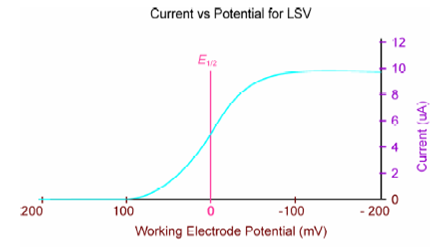Characteristics of Linear Sweep Voltammetry:
An important feature of this technique is that largest change in slope occurs around E°. The value of the potential corresponding to the point where the current is exactly half of the total current is known as half wave potential (E½) and this value is used to identify the unknown species (qualitative analysis) and the difference in the value of the current from the start to the maximum value is known as limiting current, i.e. sum of migration current + residual current and diffusion current, but after elimination of the first two the diffusion current (id) that is directly proportional to the concentration of the analyte and is used for its analytical determination (quantitative analysis)
id =KcA
while cA is the analyte concentration and K is a constant

Figure: Linear Sweep Voltammogram
Polarographic determinations with higher sensitivity can be achieved if the ratio of iF/iC is improved by other measuring techniques by increasing the Faradaic current or reducing the condenser current. Those modifications gave rise to sampled DC polarography and pulse methods.
In normal DC polarography, the electrode area is not constant and hence the current fluctuates with the life time of each drop within some range as shown in Figure. This problem can be alleviated by measuring the current once at the end of the life time of each drop and this method is called Sampled DC Polarography or Tast Polarography.